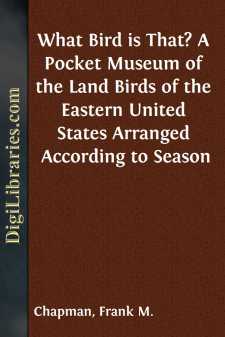Categories
- Antiques & Collectibles 13
- Architecture 36
- Art 48
- Bibles 22
- Biography & Autobiography 813
- Body, Mind & Spirit 142
- Business & Economics 28
- Children's Books 17
- Children's Fiction 14
- Computers 4
- Cooking 94
- Crafts & Hobbies 4
- Drama 346
- Education 46
- Family & Relationships 57
- Fiction 11829
- Games 19
- Gardening 17
- Health & Fitness 34
- History 1377
- House & Home 1
- Humor 147
- Juvenile Fiction 1873
- Juvenile Nonfiction 202
- Language Arts & Disciplines 88
- Law 16
- Literary Collections 686
- Literary Criticism 179
- Mathematics 13
- Medical 41
- Music 40
- Nature 179
- Non-Classifiable 1768
- Performing Arts 7
- Periodicals 1453
- Philosophy 64
- Photography 2
- Poetry 896
- Political Science 203
- Psychology 42
- Reference 154
- Religion 513
- Science 126
- Self-Help 84
- Social Science 81
- Sports & Recreation 34
- Study Aids 3
- Technology & Engineering 59
- Transportation 23
- Travel 463
- True Crime 29
What Bird is That? A Pocket Museum of the Land Birds of the Eastern United States Arranged According to Season
by: Frank M. Chapman
Description:
Excerpt
INTRODUCTION
As Curator of the Department of Birds of the American Museum of Natural History I have had exceptional facilities for the arrangement of collections designed to give students a comprehensive view of local bird-life without confusing them with unnecessary details.
Among other aids to this end a collection of 'Birds Found within 50 Miles of New York' has been placed in a special hall and so grouped that the visitor who wishes to identify some bird seen within these limits may do so with the least possible difficulty. In addition to the 'General Systematic Collection,' containing specimens of the 350-odd species of birds which have been recorded from the New York City region, there is also a 'Seasonal Collection.' This Seasonal Collection contains only the birds of the month. Its base is the 'Permanent Resident Birds,' or those which, like the Crow, are with us throughout the year. To these, the migratory species are added or subtracted, as they come or go. The collection of migratory species is therefore revised the first of each month. Birds which are due to arrive during the month are added, those which have left us are withdrawn. The Seasonal Collection thus us, at a glance, a picture of the bird-life of the month and correspondingly limits the field of our inquiry when we go to it to learn the name of some strange bird recently observed. In January, therefore, we have not to consider the birds of June, nor need we be concerned with winter birds in summer. The season of occurrence thus gives us an important clue to a bird's identity.
For somewhat more than a quarter of a century this small collection has achieved its object so effectively that I have attempted to embody the idea it demonstrates in a series of drawings which have been admirably executed by Mr. Edmund Sawyer. As foundation plates or 'collections,' we have first two 'cases' of the winter land birds of the Northeastern States, or from about Maryland northward, containing the Permanent Residents, which form part of the bird-life of every month of the year, and the Winter Visitants, or those birds which come from the North in the fall to remain with us until the following spring.
Cases 3 and 4 contain the Permanent Resident and Winter Visitant land birds of the Southern States. Whether the student is in the North or in the South he has, therefore, a 'collection' of the land birds which he may expect to find during the winter months.
Cases 5 to 8 contain the migrants arranged according to the order of their arrival from the South in the vicinity of New York City. Since it is not practicable to have cases containing collections of migrants for other latitudes, data are given showing what changes in dates should be made to adapt the schedule presented to other localities, including Washington, D.C., Ossining, N.Y., Cambridge, Mass., northern Ohio, Glen Ellyn, near Chicago, and southeastern Minnesota. The records for these localities are quoted from the author's 'Handbook of Birds of Eastern North America' to which they were contributed respectively by Dr....


